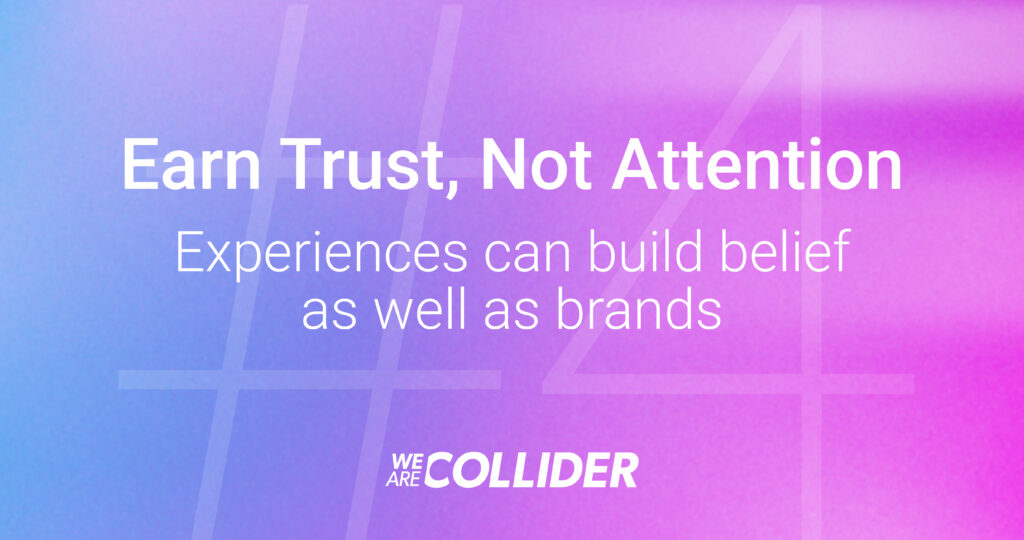Welcome to the latest blog from We Are Collider, where we’re diving into the behavioural and cultural dynamics behind immersive brand experiences.
The piece is inspired by recent work carried out by Arq, our dedicated Research and Development lab. They have published a whitepaper called ‘Experience 3.0,’ which digs into the nitty-gritty of how brands can harness behavioural science to augment their customers’ reality. The paper explores how, rather than treating immersive media as a novelty, brands can use AR, VR, virtual gamified worlds and decentralised digital environments to create more meaningful (and behaviourally-effective) immersive brand experiences.
The report also identifies a fundamental shift in how brands and consumers are interacting and suggests a specialist framework for understanding this relationship. The result is the “STAGE” model, a behaviourally-informed framework based on academic research, expert interviews and an in-depth survey of 550 UK adults. As part of the model, Arq identified five behavioural science-based levers for effective Immersive Media activations:
- Self: empower personal identity, ownership and creativity
- Transformative: enable growth, meaning, inspiration, or real-world impact
- Accessible: ensure ease of use, inclusivity, trust and comfort
- Gamified: use play, competition, interactivity and social bonding
- Extraordinary: Deliver awe, surprise and impossible experiences
Today, we’re going to be looking closely at the very first of those levers.
Me, myself and I – understanding the idea of ‘SELF’
It’s become something of a cliche to say that people want to ‘lose themselves’ in immersive experiences, but that’s not quite it. It’s less about disappearing and more about showing up: feeling seen, connected and part of the story, not separate from it.
As Arq have amply demonstrated with their research, people just aren’t interested in some bland, featureless, impersonal experience that has no relevance to their lives. Instead, they are looking for something real, relatable and relevant. They want to see themselves reflected in those experiences. Think personalisation, not passivity. Identity, not intrusion. This key insight is why Arq have made the SELF so central to their framework.
So, what is ‘Self’? In the research, people often talked about Web3 experiences that “were all about me personally,” or that “felt highly personalised,” or that “let me improve upon myself, my look, my style.” These are indicators of what users want: experiences that reflect them, shape them, and occasionally flatter them. This reflects a broader shift in consumer psychology as people move away from the more traditional methods of passively consuming experiences to actively shaping them.
The psychological science of SELF
The science is crystal clear. ‘Social Identity Theory,’ for example, tells us that people engage more with things that feel personally relevant, while The Proteus Effect shows that our digital avatars actually shape how we act in the real world. And Self-Determination Theory reminds us that autonomy, creativity and ownership are rocket fuel for engagement.
As Mark Lycett, Professor of Digital Innovation at Royal Holloway, University of London, noted in our expert interviews: “It gives an opportunity for consumers, through notions of self-sovereign identity, to control the way that their personas are perceived in the digital world.” Or in the words of Henry Stuart, Co-Founder and CEO at VISUALISE: “It’s like augmented manifestation.”
The main takeaway is that digital spaces are becoming extensions of the self, and the brands that truly grasp this shift are no longer just trying to build engagement; they’re trying to build relationships. Tapping into this idea of ‘SELF’ is an incredibly effective way of doing exactly that.
How brands are pulling the ‘self’ lever IRL
Some of the smartest names in marketing are already using ‘Self’ to serious effect when they put together their immersive brand experiences.
Take Netflix House, which opened in 2025. They take the concept of a theme park and drag it into the 21st century, creating an identity playground for the guests. Fans of Stranger Things, Bridgerton or Squid Game won’t just visit; they will inhabit the worlds of their favourite shows. Netflix House taps into identity, fandom and agency, and by allowing people to physically engage with narratives that reflect their tastes and values (and even perform or play within them), the experience becomes a mirror of the self. It’s more than entertainment, it’s personalised immersion where fans feel seen, involved and emotionally connected.
Or you could look at LinkedIn Studio at Cannes Lions. You might not expect the world’s most buttoned-up professional platform to show up with cutting-edge flair, but here they were, letting visitors generate AI-powered content based on their profiles. Your professional identity, filmed, polished and packaged, with Adobe on hand to make sure you didn’t look like you were pitching a startup in 2012. These experiences weren’t flashy for the sake of it. They worked because they were personal. That’s what drove the emotional connection, made people stay longer, and inspired them to act.
Self-importance – why this lever matters
Immersive brand experiences used to be about attention. Today, they are about identity. The rise of avatar-driven platforms like Roblox and Zepeto is so much more than a teenage trend; it’s a symptom of a wider shift. People want to be in your world, and they want to see themselves reflected. And most crucially, this ‘self’ lever isn’t all about warm fuzzy feelings, vibes, or ego boosts — it’s backed by the data too.
In Arq’s regression analysis, the ‘Self’ lever was strongly linked to:
- Improved brand perception
- Higher likelihood of action (clicking, sharing, buying)
- Stronger memory recall
Passing on the passive
In summary, immersive brand experiences work best when people feel like they actively belong in them. The lever of ‘self’ can be a useful gateway to a deeper impact, both emotionally, socially and commercially, as it allows customers to move beyond passivity. They don’t want to be bystanders; they want to be involved, whether that is in a fantasy world, a branded space, or an AI-edited rooftop video in Cannes.
That’s what the Self lever unlocks, and where brand impact really begins.
Stay tuned for the introduction of the second STAGE lever, going beyond participation and creating experiences that are genuinely ‘Transformative.’
Want to unlock the Self lever in your next immersive brand experience? Email Charlotte to explore how Arq’s STAGE model can sharpen your next activation: charlotte.bunyan@arq-lab.com





